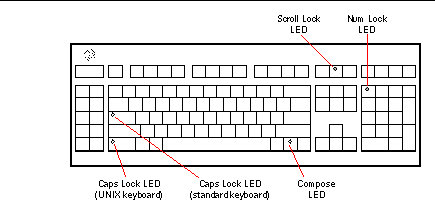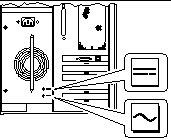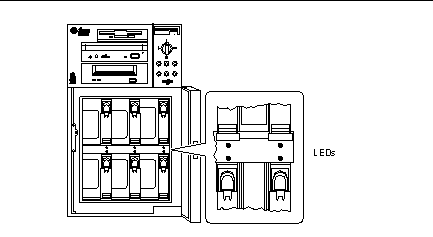Error Indications
The system provides error indications via LEDs and error messages. Using the two in combination, you can isolate a problem to a particular field-replaceable unit (FRU) with a high degree of confidence.
The system provides fault LEDs in the following places:
-
Front panel
-
Keyboard
-
Power supplies
-
Disk drives
Error messages are logged in the /var/adm/messages file and are also displayed on the system console by the diagnostic tools.
Front Panel LEDs
Front panel LEDs provide your first indication if there is a problem with your system. Usually, a front panel LED is not the sole indication of a problem. Error messages and even other LEDs can help to isolate the problem further.
The front panel has a general fault indicator that lights whenever POST or OBDiag detects any kind of fault. It addition, it has LEDs that indicate problems with the internal disk drives, power supply subsystem, or fans. See "About the Status and Control Panel" for more information on these LEDs and their meanings.
Keyboard LEDs
Four LEDs on the Sun Type-5 keyboard are used to indicate the progress and results of POST diagnostics. These LEDs are on the Caps Lock, Compose, Scroll Lock, and Num Lock keys, as shown below.
Figure 12-5

To indicate the beginning of POST diagnostics, the four LEDs briefly light all at once. The monitor screen remains blank, and the Caps Lock LED blinks for the duration of the testing.
If the system passes all POST diagnostic tests, all four LEDs light again and then go off. Once the system banner appears on the monitor screen, the keyboard LEDs assume their normal functions and should no longer be interpreted as diagnostic error indicators.
If the system fails any test, one or more LEDs will light to form an error code that indicates the nature of the problem.
Note -
The LED error code may be lit continuously, or for just a few seconds, so it is important to observe the LEDs closely while POST is running.
The following table provides error code definitions.
Table 12-5|
LED |
|
|||
|---|---|---|---|---|
|
Caps Lock |
Compose |
Scroll Lock |
Num Lock |
Failing FRU |
|
X |
|
|
|
Main logic Board |
|
|
X |
|
|
CPU 0 |
|
|
X |
|
X |
CPU 1 |
|
X |
|
|
X |
No memory detected |
|
X |
X |
|
|
Memory bank 0 |
|
X |
X |
|
X |
Memory bank 1 |
|
X |
X |
X |
|
Memory bank 2 |
|
X |
X |
X |
X |
Memory bank 3 |
|
|
|
|
X |
NVRAM |
Note -
The Caps Lock LED blinks on and off to indicate that the POST diagnostics are running. When it lights steadily, it indicates an error.
Power Supply LEDs
Power supply LEDs are visible from the rear of the system. The following figure shows the LEDs on the power supply in bay 0.
Figure 12-6

The following table provides a description of each LED.
Table 12-6|
LED Name |
Icon |
Description |
|---|---|---|
|
AC-Present-Status |
|
This green LED is lit to indicate that the primary circuit has power. When this LED is lit, the power supply is providing standby power to the system. |
|
DC Status |
|
This green LED is lit to indicate that all DC outputs from the power supply are functional. |
Disk LEDs
The disk LEDs are visible from the front of the system when the bottom door is open, as shown in the following figure.
Figure 12-7

When a disk LED lights steadily and is green, it indicates that the slot is populated and that the drive is receiving power. When an LED is green and blinking, it indicates that there is activity on the disk. Some applications may use the LED to indicate a fault on the disk drive. In this case, the LED changes color to yellow and remains lit. The disk drive LEDs retain their state even when the system is powered off.
Error Messages
Error messages and other system messages are saved in the file /var/adm/messages.
The two firmware-based diagnostic tools, POST and OBDiag, provide error messages either locally on the system console or remotely on an RSC console. These error messages can help to further refine your problem diagnosis. The amount of error information displayed in diagnostic messages is determined by the value of the OpenBoot PROM variable diag-verbosity. See "OBDiag Configuration Variables" for additional details.
- © 2010, Oracle Corporation and/or its affiliates
